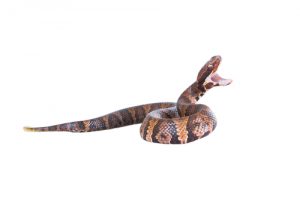Is That Snake Poisonous?
By Chris Williams on June 5, 2012.
Q. My husband found a snake in our backyard. He killed it because he swears it was a copperhead. He kept it and wants to get it identified. Everything I can find says we do not have copperheads in our state. Is there a way to tell if it’s a copperhead? Please answer quickly before this thing starts to smell!
A. Let me just say it would be very unlikely that it’s a copperhead if you are in our New Hampshire/Massachusetts area. The only poisonous snakes in the U.S. are rattlesnakes, copperheads, cottonmouths (water moccasins), and coral snakes. Most regions have only one or two of these snakes. There’s a lot of confusion about what poisonous snakes we have in New Hampshire/Massachusetts, or if we have any at all. Most reports of poisonous snakes are misidentifications since many harmless snakes look like and mimic poisonous snakes. Here’s the scoop on poisonous snakes from the folks that should know.
 The New Hampshire Fish and Game Department says that there are 11 snake species that occur in New Hampshire and only one, the very rare timber rattlesnake, is poisonous. Five of the 11 snakes are state protected, including the timber rattler. If you think you see a timber rattler, Fish and Game says to leave it alone and let them know. Many people will argue that there are copperheads in New Hampshire but those people are confusing the copperhead with the eastern milk snake that looks very similar and does occur in the state.
The New Hampshire Fish and Game Department says that there are 11 snake species that occur in New Hampshire and only one, the very rare timber rattlesnake, is poisonous. Five of the 11 snakes are state protected, including the timber rattler. If you think you see a timber rattler, Fish and Game says to leave it alone and let them know. Many people will argue that there are copperheads in New Hampshire but those people are confusing the copperhead with the eastern milk snake that looks very similar and does occur in the state.
According to the experts at the University of Massachusetts, there are 14 snake species in Massachusetts, including two poisonous species: copperheads and timber rattlesnakes. Again, they are both rarely seen. It’s estimated that there are no more than a few hundred of these poisonous snakes in the entire state. Even though they are protected, their numbers are declining. The rattlers are known to exist at only a dozen or so widely scattered sites in mountainous regions and the distribution of copperheads is even more restricted. Contrary to popular belief, there are no water moccasins (cottonmouths) in either state. People are confusing these with harmless water snakes.
The chance of even seeing a poisonous snake around here is remote. So, it would be very surprising if your husband’s snake was a copperhead. The chance of being bitten by a poisonous snake is even more remote since both timber rattlers and copperheads are shy and reclusive. They bite only in self-defense.
To answer your question, yes there are ways to tell a poisonous snake from its look-alike harmless cousin. A poisonous snake (also known as a pit viper) has a deep pit on each side of the head between the eye and the nostril. A nonpoisonous snake doesn’t have that pit. The scales on the underside of a pit viper’s tail are in one row across. The scales beneath the tail of a nonpoisonous snake are in two rows. And, of course, rattlesnakes have a “rattle” at the end of their tail. But, the most noticeable clue for people who are hopefully observing the snake from a distance is the shape of the pupil of the eye. A poisonous snake’s pupil is not round but is vertically egg-shaped, and in bright light may be almost a vertical slit. The pupil of a nonpoisonous snake’s eye is round.